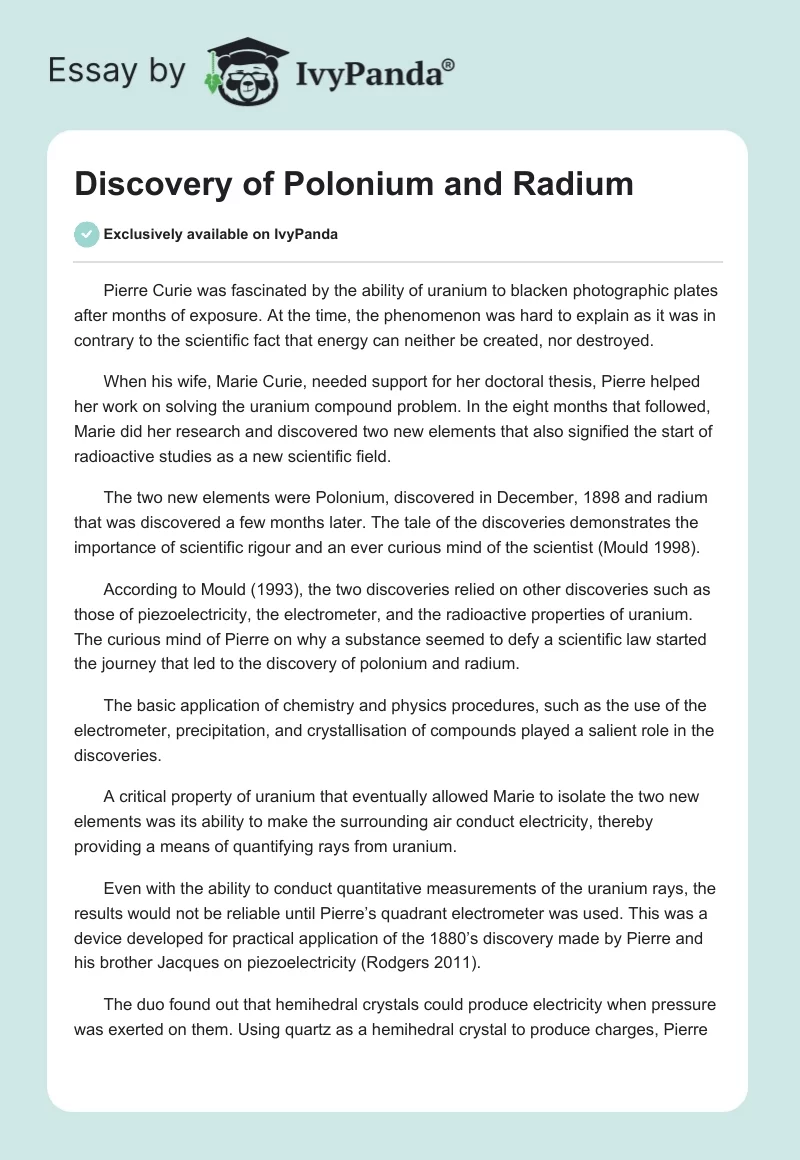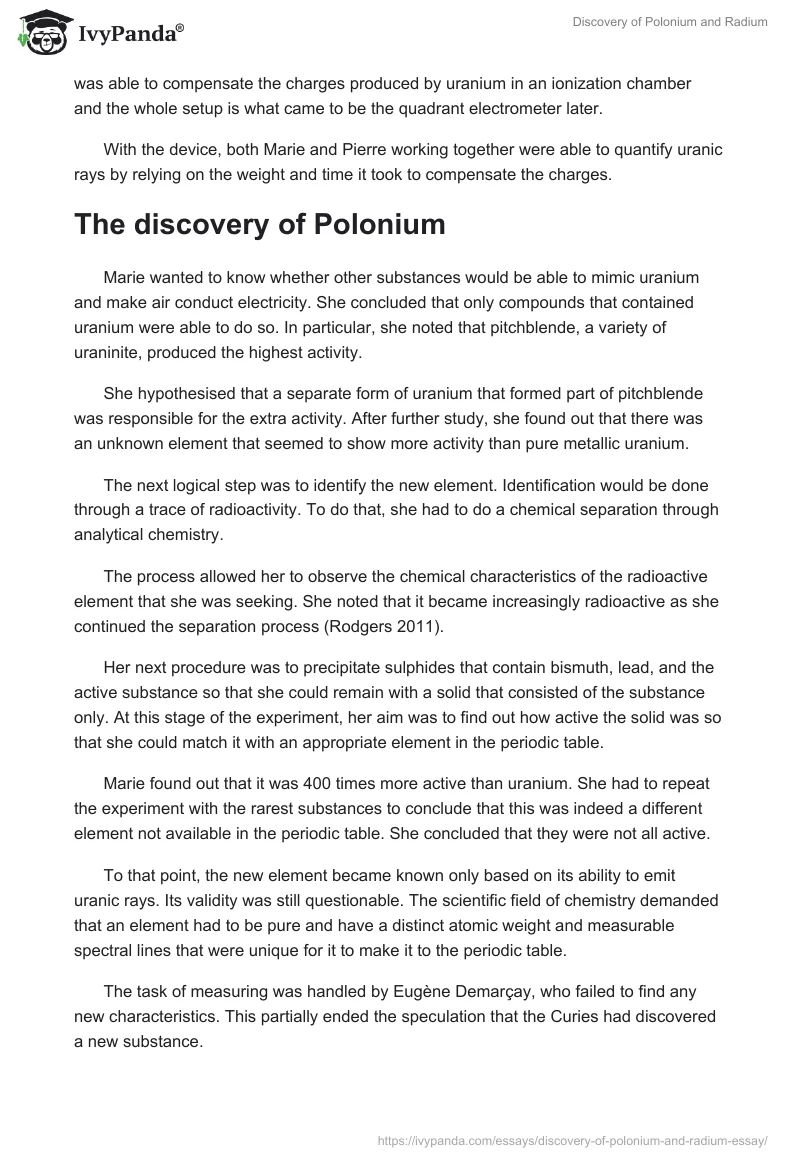Pierre Curie was fascinated by the ability of uranium to blacken photographic plates after months of exposure. At the time, the phenomenon was hard to explain as it was in contrary to the scientific fact that energy can neither be created, nor destroyed.
When his wife, Marie Curie, needed support for her doctoral thesis, Pierre helped her work on solving the uranium compound problem. In the eight months that followed, Marie did her research and discovered two new elements that also signified the start of radioactive studies as a new scientific field.
The two new elements were Polonium, discovered in December, 1898 and radium that was discovered a few months later. The tale of the discoveries demonstrates the importance of scientific rigour and an ever curious mind of the scientist (Mould 1998).
According to Mould (1993), the two discoveries relied on other discoveries such as those of piezoelectricity, the electrometer, and the radioactive properties of uranium. The curious mind of Pierre on why a substance seemed to defy a scientific law started the journey that led to the discovery of polonium and radium.
The basic application of chemistry and physics procedures, such as the use of the electrometer, precipitation, and crystallisation of compounds played a salient role in the discoveries.
A critical property of uranium that eventually allowed Marie to isolate the two new elements was its ability to make the surrounding air conduct electricity, thereby providing a means of quantifying rays from uranium.
Even with the ability to conduct quantitative measurements of the uranium rays, the results would not be reliable until Pierre’s quadrant electrometer was used. This was a device developed for practical application of the 1880’s discovery made by Pierre and his brother Jacques on piezoelectricity (Rodgers 2011).
The duo found out that hemihedral crystals could produce electricity when pressure was exerted on them. Using quartz as a hemihedral crystal to produce charges, Pierre was able to compensate the charges produced by uranium in an ionization chamber and the whole setup is what came to be the quadrant electrometer later.
With the device, both Marie and Pierre working together were able to quantify uranic rays by relying on the weight and time it took to compensate the charges.
The discovery of Polonium
Marie wanted to know whether other substances would be able to mimic uranium and make air conduct electricity. She concluded that only compounds that contained uranium were able to do so. In particular, she noted that pitchblende, a variety of uraninite, produced the highest activity.
She hypothesised that a separate form of uranium that formed part of pitchblende was responsible for the extra activity. After further study, she found out that there was an unknown element that seemed to show more activity than pure metallic uranium.
The next logical step was to identify the new element. Identification would be done through a trace of radioactivity. To do that, she had to do a chemical separation through analytical chemistry.
The process allowed her to observe the chemical characteristics of the radioactive element that she was seeking. She noted that it became increasingly radioactive as she continued the separation process (Rodgers 2011).
Her next procedure was to precipitate sulphides that contain bismuth, lead, and the active substance so that she could remain with a solid that consisted of the substance only. At this stage of the experiment, her aim was to find out how active the solid was so that she could match it with an appropriate element in the periodic table.
Marie found out that it was 400 times more active than uranium. She had to repeat the experiment with the rarest substances to conclude that this was indeed a different element not available in the periodic table. She concluded that they were not all active.
To that point, the new element became known only based on its ability to emit uranic rays. Its validity was still questionable. The scientific field of chemistry demanded that an element had to be pure and have a distinct atomic weight and measurable spectral lines that were unique for it to make it to the periodic table.
The task of measuring was handled by Eugène Demarçay, who failed to find any new characteristics. This partially ended the speculation that the Curies had discovered a new substance.
Confirmation of the existence of polonium as a separate element came a few years later when Pierre and Marie noticed their sample was disappearing progressively.
At the time, no one knew that the half-life of polonium was 138 days (Rodgers 2011). Marie was lucky to have worked on her sample for three months only. A spark spectrum of the disappearing sample revealed that it was indeed a different element because it had few additional distinct lines.
Further research by other scientists led to the discovery of the half-life and contributed to the research literature on the element and its practical applications.
The discovery of Radium
Marie concluded that the radiation strength of a compound depended on the amount of uranium or thorium contained in it and not on the compound itself. She concluded this based on the fact that different compounds from the same element showed different characteristics in terms of physical and chemical properties.
The observation led to the realization that the ability to radiate comes from inside the atom and not on the arrangement of atoms when they form a molecule. This deductive reasoning of the source of radiation is what came to be the foundational knowledge of separating uranium and thorium compounds to end up with polonium and radium.
It was months after getting polonium that Pierre and Marie claimed to have found a new element that resembled barium, but it had a higher radioactive property. As they had done with polonium, they commenced on a tedious work of separating and analysing different compounds to validate their findings.
Mould (1998) reports that the process involved chemical separation of compounds, which was done by Marie, and physical measuring of their masses done by Pierre. Much of the separation involved heating. Marie had to stir the boiling mass for hours to aid the process.
The final one decigram of radium chloride came from thousands of crystallisations achieved from several tons of the initial compounds used for the research. The pure radium chloride allowed Marie to determine the atomic weight of radium as 225.
She was able to do this because the other elements of the compound had distinct properties. She used the knowledge to arrive at her deductive conclusion.
She obtained barium chloride by starting with pitchblende, as reported by Davis (1995). She was then able to get radium chloride through the fractional crystallisation process. In this process, barium as an element crystallised and left the compound.
After separation, the next process was to analyse the remaining substance through spectroscopy. When Marie looked at the spectrum of barium chloride, she was unable to assign several lines to any known element. Given that the substance was a true copy of barium, she suggested its name be radium.
The seemingly easy discovery of radium that just took a few months after that of polonium was aided by the characteristic advantages of the new element. Unlike polonium, barium has a half-life of 1600 years; thus, it did not disappear progressively as Marie worked on it.
From the original pitchblende ore, the concentration of radium was about 5000 times more than that of polonium. That increased its odds of discovery. Lastly, it was fairly easy to assign the element a place in the periodic table because its distinct lines were clearly visible in the spectrum analysis (Davis 1995).
Conclusion
Although the discovery of polonium appears to be accidental, it still clearly highlights the nature of scientific inquiry. Without the curiosity surrounding the uranium radioactivity puzzle, the scientists would not have embarked on a discovery journey that led them to two new elements.
The continuous research on the elements and their compounds even after their classification would later aid in their application in various processes in both chemistry and physics. Marie was able to finally isolate radium as a metal after collaborating with André Debierne.
Her husband conducted tests with his body using radium to demonstrate its effect on body cells and later suggested in a demonstration that it could be used in eliminating cancerous cells as a treatment compound.
List of References
Davis, JL 1995, ‘The research school of Marie Curie in the Paris faculty’, Annals of Science, vol. 52, no. 4, pp.321-55.
Mould, FR 1993, A century of X-rays and radioactivity in medicine: With empasis on photographic records of early years, Institute of Physics Publishing, London.
Mould, RF 1998, ‘The discovery of radium in 1898 by Maria Sklodowska-Curie (1867-1934) and Pierre Curie (1859-1906) with commentary on their life and times’, British Journal of Radiology, vol. 71, no. 852, pp.1229-1254.
Rodgers, G 2011, Descriptive inorganic, coordination, and solid state chemistry, Brooks/Cole, Cengage Learning, Belmont, CA


